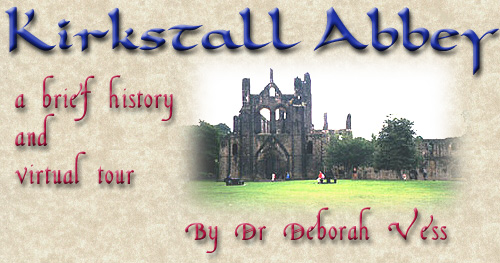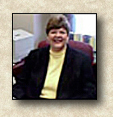 |
|
Brief History of Kirkstall Abbey Pictorial Tour Brief History of Kirkstall AbbeyKirkstall Abbey is one of the best preserved ruins in England. The Abbey was completed sometime between 1152 and 1182. Its ruins are complete up to its full height, which is unusual among monastic ruins, and it is an excellent example of early Cistercian architecture. Kirkstall Abbey is an outgrowth of Fountains Abbey. The abbot of Fountains, Alexander, left Fountains in 1147 and founded a monastery in Barnoldswick on the lands of Henry de Lacy. The climate was very harsh here, and the local villagers were not receptive to the new community, and they set out in search of lands better suited to their monastic life. They found land in the Aire valley on the lands of William of Poitou, who was a vassal of Henry de Lacy. On May 19, 1152, the monks moved from Bardoldswick and founded Kirkstall Abbey. Many Cistercian monks took the name "Mary" as a second name, which reflected their devotion to the Virgin. Kirkstall Abbey also reflects this devotion, as it was dedicated the Virgin Mary. The new community had an abbot, twelve monks, and ten lay brothers. The number twelve was always the number of monks chosen to found to accompany a new abbot to found a community, as this was the number of the apostles who accompanied Christ. The church and all the monastic buildings were completed quickly, all during the lifetime of Abbot Alexander. The church and the grounds reflect the Cistercian love of simplicity in design, without excessive decoration, a reaction to the excesses of the Cluniacs. Kirkstall, like all Cistercian communities, had a large group of conversi or lay brothers living there. Their presence is reflected in the west range complex. Life here, as in all Cistercian monasteries, was difficult. Cistercian communities were often founded in very desolate places, and the monks subsisted on a vegetarian diet only rarely supplemented by meat, until later in the Middle Ages. There was no heat in the community except in the kitchen and warming room. The community here was never particularly wealthy, as was Fountains Abbey in the north. No major rebuilding projects were undertaken until the sixteenth century, when Abbot William Marshall rebuilt the roof of the church, and the great tower, along with battlements and turrets. Unfortunately, the renovation project did not usher in a new era of life at Kirkstall, as the English Reformation would soon dissolve most of the monastic houses in England and Ireland, as well as Scotland and Wales. In 1539 Kirkstall Abbey was dissolved along with other lesser houses. The abbey was given to the Archbishop of Canterbury, Thomas Cramer; after Cramer's execution in 1556, ownership of the abbey passed back to the crown. In 1583, Robert Savile purchased the abbey, and it remained in his family until 1671. Through marriage, the abbey passed to the Brudenells, Earls of Cardigan. The abbey lost its roof, and quickly became a ruin overgrown with vegetation. It was a very picturesque site visited by many well-known authors, such as Walpole, Gray and Southey. In 1889, the Cardigan estates were sold, and the abbey itself was purchased by Colonel John North. North deeded the abbey and its grounds to the City of Leeds. The abbey grounds were stripped of excess vegetation and tons of rubble were removed. On September 14, 1895, in a ceremony recalling the origins of the founders of Kirkstall from Fountains Abbey near Ripon, the Lord Bishop of Ripon and the Lord Mayor of Leeds opened the grounds to the public. Despite the years of decline and the lack of many major rebuilding projects in the Middle Ages, Kirkstall Abbey remains one of the best examples of early Cistercian life in England. Pictorial TourThe Choir Monks' Dormitory and Reredorter The West Range and the Lay Brothers' Lane
To return to the medieval monasticim home page, click here. To return to the virtual tours page, click here.
|
